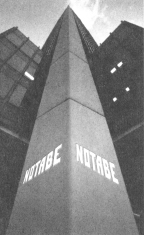Trapped!: The 2031 Journal of Otis Fitzmorgan (20 page)
Read Trapped!: The 2031 Journal of Otis Fitzmorgan Online
Authors: Bill Doyle

WARNING:
This message gives away parts of the story!
This note is different than many others I've written for the Crime Through Time series. Normally, I'd tell you not to use
this book to study for a history test. But unless you're reading this in 2032 or after, that's not going to be a problem.
Just remember, Judge and the other characters are inventions of my imagination.
Most of the technology, however—such as cool uses for nanobots—is based on real scientific advances and might be right around
the corner.
NASA is considering building a space elevator. There'd be no need for dangerous and expensive launches from Earth. Satellites
and spacecraft could be sent off into space from the top of the elevator. Imagine: You might ride the space elevator someday.
Even with all this amazing technology in the story, I wanted Otis and his friends to rely on good, old-fashioned detective
work to crack the case. Clever gadgets are no substitute for using your head in tricky situations.
Finally, one thing I loved about writing this book was letting Asyla show all her cards. Her character was like a seed I planted
in the first book—and she finally got to blossom here. Even though she's the villain, it felt great to finally unleash her!
Like Otis, I have the feeling we may not have seen the last of Asyla … or Judge!
Yours in time,


Bill Doyle was born in Lansing, Michigan, and wrote his first mystery when he was eight. He loved seeing the shock on people's
faces when they discovered the. identity of the story's villain—and knew then that he Was hooked on Writing. Bill has written
for Sesame Workshop, Leap Frog, Scholastic, R
OLLING
S
TONE
, TIME
FOR
K
IDS
, and the Museum of Natural History. He lives in New
York City with. a mysterious dachshund named Esme.
Check out these other gripping
Crime Through Time™ books!
Now in stores!
 | | |  | | |  |
 | | |  |
EXTRA! EXTRA!
Don't forget to read the newspaper in the back of each book!
2031 Edition
$3.50 We Have an “EYE” for News
GOING UP…
WAY, WAY UP!

So you thought you needed a rocket to get to space? Think again! Last month, the first Space Elevator officially opened. Special
cars called climbers will carry people and cargo up and down a very strong, thin ribbon that extends 60,000 miles up into
space. These climbers will use magnetic clamps—they look kind of like the treads of a tank—that will grab onto the ribbon
to pull the car up or slowly lower it down. About eight climbers can go up and down at a time and a one-way trip will take
six days. Lasers on the surface will shine on the climbers' solar panels and provide them with power.
A space station and private hotel are waiting for passengers at the top of the Elevator. “Every room in our hotel has an out-of-this-world
view,” says Marvin Jackson, owner of the hotel.
Wealthy travelers who are looking for the ultimate getaway can pay the steep price for the Elevator ticket and stay in one
of the hotel's gorgeous rooms.
Beyond the travel opportunities for tourists, scientists are drooling over the new possibilities for space exploration. “It
will be much, much cheaper to launch satellites and spacecraft from the top of the Elevator than from Earth,” says Dr. Alex
Podeszwa of the Federal Space Agency. “Ships that leave the station won't have to waste fuel fighting against Earth's gravity
to escape the atmosphere—that means they'll have more fuel to go deeper into space.”
Is the Elevator dangerous? Dr. Podeszwa says, “The only real danger is from airplanes or satellites that might accidentally
strike the ribbon.”
The idea for a Space Elevator has been around for about 150 years. Science fiction writer Arthur C. Clarke wrote about a space elevator 52 years ago in his book
The Fountains of Paradise.
But materials for the Elevator ribbon, or cable, were always too heavy to stretch for thousands of miles into space. It wasn't until 1991 that the Elevator became a real possibility. That's
when scientists discovered a new material called ”carbon nanotubes.” This lightweight material is 100 times as strong as steel.

Who knows? This new Space Elevator may do for space what the transcontinental railroad did for the West in the 1800s!
NEWS
Putting Private Eyes in Prison
